Protected Cruiser Askold (1900)
The five-stack Russo-German cruiser
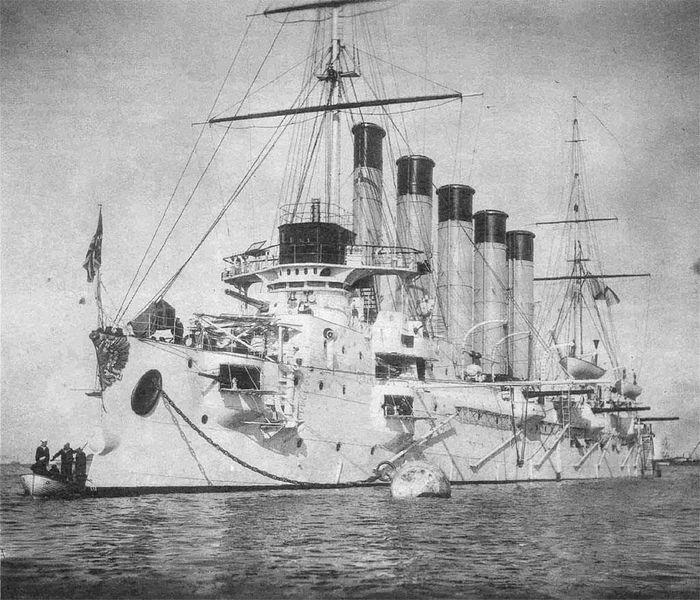
Askold in Kronstadt, 1902
As part of the many cruisers ordered in emergency by the Russian Imperial staff to bolster the newly created Pacific fleet, Askold (Аскольд) named after the legendary Medieval Varangian warlord, was ordered in Germany as Russian Yards were at full capacity. She registered at the same time of other foreign-built cruisers such as Varyag (Cramp, USA), Novik (Schichau, Germany) and Boyarin (Burmeister & Wain, Denmark). Completed in 1902, she was usually reckoned the fastest of the larger Russian cruisers. She was one of the rare ship to escape the Russo-Japanese war with Novik, and in WWI she served in the Mediterranean and later the the White Sea, seized by the British recommissioned in August 1918 as Glory IV and later scrapped. She was also nicknamed by the latter “Woodbines” after the thin cigarettes popular at the time…
Port Arthur was a strategic location obtained after the treaty concluding the first Sino-Japanese war of 1894. The port was rapidly developed as a fully-fledged fortified military base. In 1895 the admiralty recoignised the need to built battleships and additional cruisers for this station, and this led to a multiple order to various Yards, Russian and Foreign. For the latter, two cruisers were ordered based on the same specifications, which ended as Varyag and Askold. The next Novik was a completely different design, which was replicated with the Bogatyr and the Jemtchug pair built in Russia afterwards.
After the decision was made to build a new cruiser (1st rank) on October 10, 1896, junior shipbuilder E. R. de Grofe was appointed its chief builder. Captain of the 2nd rank N. K. Reitsenshtein was appointed to supervise the construction. On January 6, 1899, N. K. Reitsenstein became ship’s commander and A. F. Stemman, P. F. Gavrilov and representatives of the Russian diplomatic corps met in Germany with the Kaiser Wilhelm II. During the conversation, the later advised for the powerplant to install Thornycroft’s boilers, supposed to be installed at first. They were built under licence by his “personal yard”. The cruiser with its final design was eventually laid down on June 8, 1899 in Germaniawerft. By December 1899, E. R. de Grofe arrived in Kiel overseeing the construction of Bogatyr at Vulkan, Stetin at the same time.
The contracted yard, Germaniawerft in Kiel, obliged to the Russian admiralty requirements but produced a very unique design overall. It was never repeated and remains singular, not only amidst Russian but also German cruisers. An oddball of a cruiser, but which on trials astonished the press for its record-breaker high speed. The Kaiser was supposedly pleased by the result, mraising his engineers, and this fit well with the Russian admiralty, as this superior speed to Japanese or British cruisers could come in handy in many situations in the far east.
Design of the class
Hull and general design
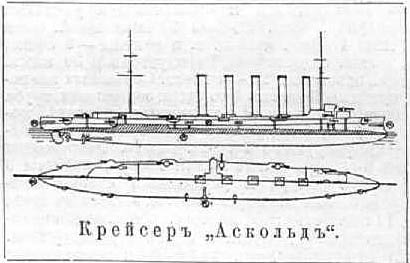
Askold had a unique appearance with five tall funnels, being flush-decked with a short forward superstructure which did not reach the bows. One of the 6-in gun was mounted on the short bow deck, and the rest was at upper deck level, one aft and five on either broadside. The 11-pdrs were located at main deck level. The hull displaced 5,910 t (5,820 long tons) fully loaded, and measured 132.5 m (434 ft 9 in) overall, for a beam of 15 m (49 ft 3 in) and draught of 6.2 m (20 ft 4 in).
The hull was assembled according to the checkered (bracket) framing system. It was divided by 12 watertight bulkheads, making 13 compartments for ASW protection. The wheelhouse was provided according to the original project, in contrast to the Novik cruiser. But she emerged as “barebone” during trials in 1901, without enclosed bridge, which was open air, built directly atop the generously-sized conning tower. In 1902 a small wooden bridge was built around the steering wheel and housing voice pipes and charburn.
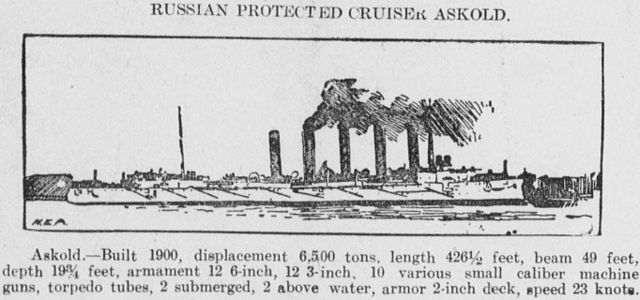
Askold in Jane’s 1904
If the main feature of the ship, her characteristic five-thin heavenly spaced funnels made for a silhouette unique in the Russian fleet, and it was compounded by her flush deck hull, adopting to save weight, approximatevely one deck higher at the bow compared to the stern. The former was completed by a ram in a caracteristic crescent-shape.
The cruiser “Askold”, very much a “show boat” of Germaniawerft, entered service in 1901 with an artillery covered by armored shields, a very reliable, economical and powerful machinery. At the same time, her hull lacked overall strenght, and her interior was cramped. She was still a better proposition overall compared to “Varyag” and “Bogatyr” for range and speed.
Armour protection layout
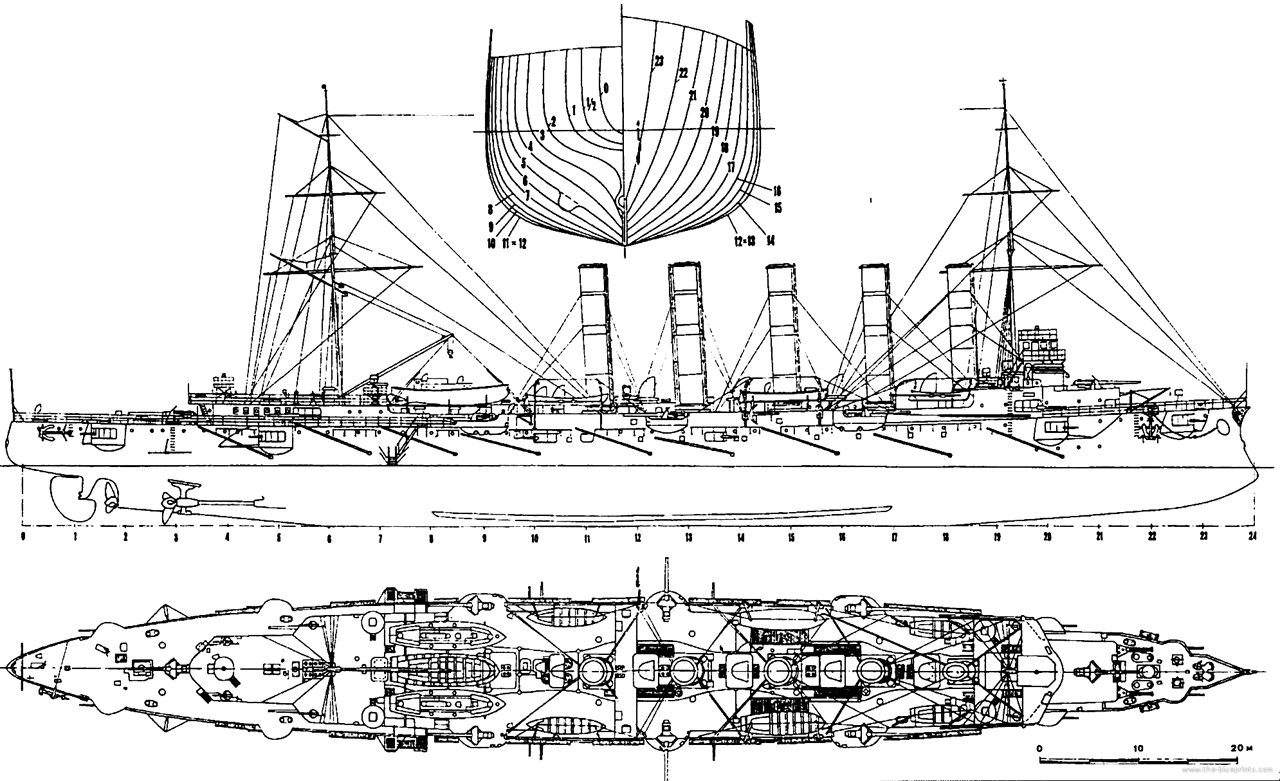
The armored deck was what made her a typical protected cruiser for the day. It was an internal turtleback structure at waterline livel, composed of two plating layers: The lower one is made of shipbuilding steel, 10-15 mm (0.5-in) while the upper one was properly an armor late with a steel alloy with nickel from 30 (1-in) to 60 mm (2.5 in) thick, from the flat section to the side sloped sections.
The flat section reached thus 40 mm total or 2-in (10 + 30 mm), with side slopes of 75mm total or 3-in (15 + 60mm) or even 100 mm or 4-in (10 + 30+ 60 mm) in the most vulnerable locations. The protective deck was thus 2-in thick with 3-in slopes and 4-in above the engine room hatch glacis. The Conning Tower had 6-in (152 mm) walls and ammunition tubes as the bow and stern torpedo tubes were 2-in thick.
The funnel crowns and ammunition supply hoists coming from the armored deck and up to the weather deck were protected by 40-mm vertical armor plating. The backup internal steering compartment was protected by 100 mm of sloped armored coaming. Surface torpedo tubes were covered with 60 mm (-in) vertical armour, 30 mm below and above. Total armor weight for this ship was 705 tons, for a displacement of 5,000 tons so a 7.14 ratio.
Powerplant
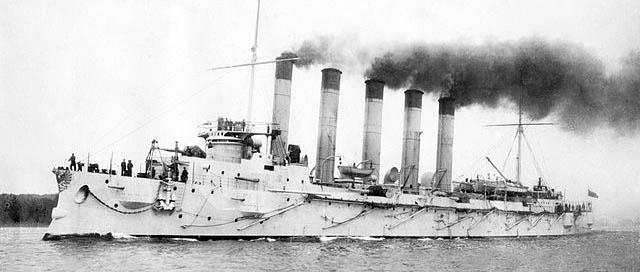
Askold on sea trials in Kiel
Her machinery was located in two engine rooms and five boiler rooms. Her three three three-blade propellers, one axial, for cruising, two outer for speed, were driven each by a triple-expansion four-cylinder steam engine. Total design capacity as designed was 19,500 hp (3 × 6500 shp). They were supposed being her to 23 knots. The forward engine room housed the two VTE engines driving the outer propellers. The stern engine room drove the axial propeller. The right and left screw propeller rotated respectively to the right and left, but the axial one was left-rotating.
Each VTE steam unit combined a high and a medium pressure cylinder, and two low pressure cylinders. The cylinder diameter were 930, 1440 and 1630 mm respectively. The piston stroke was the same for all at 950 mm. Steam was provided by nine modern Thornycroft-Schultz boilers, eight of which were placed in pairs, in four boiler rooms, and one in the fifth boiler room. Total surface was 107 m² (1,151 sq ft.) and total heating surface was 5020 m² (large boiler – 580 m², small – 480) or 54,000 sq feet. Boilers and machines proved to be reliable and very economical: Askold made a cruise of 18,500 miles in 1902 burning only 7,300 tons of coal, while the US-built Varyag needed 8,000 tons for less than half of this, 8,000 miles.
On August 19, at a preliminary test before acceptance tests, the chief engineer communicated by voicepipe to the bridge a total of 21,200 indicated horsepower which provided a speed of 23.25 knots, the average speed for 10 runs for 3 hours at 121 rpm was 21.85 knots. Her standard output was 19,650 shp (14,650 kW).
Askold for electric power and lighting was provided with six Siemens and Halske steam dynamos, with a total capacity of 336 kW.
Armament

Askold in Jane’s 1903
Askold’s Artillery consisted of:
-Twelve 152 mm/52 (Canet) in deck and casemates protected by armor shields.
-Twelve 75 mm/50 Canet QF cannons in hull’s sponsons or side casemates. In heavy weather they were not very useful.
-Eight single-barreled 47 mm Hotchkiss cannons on the upper deck and superstructures.
-Two landing 63.5-mm Baranovsky cannons on wheeled carriages for landing parties.
-Two “free mount” 37mm Hotchkiss cannons which could be installed on steam pinnaces for the same.
-Four Maxim 0.8 mm machine guns, also dismountabkle for a landing party.
-Six 381 mm torpedo tubes, 457 mm (18 in) of the German type, one each at the bow and stern, and two pairs below the waterline.
Main: 12x 152mm/52 Canet
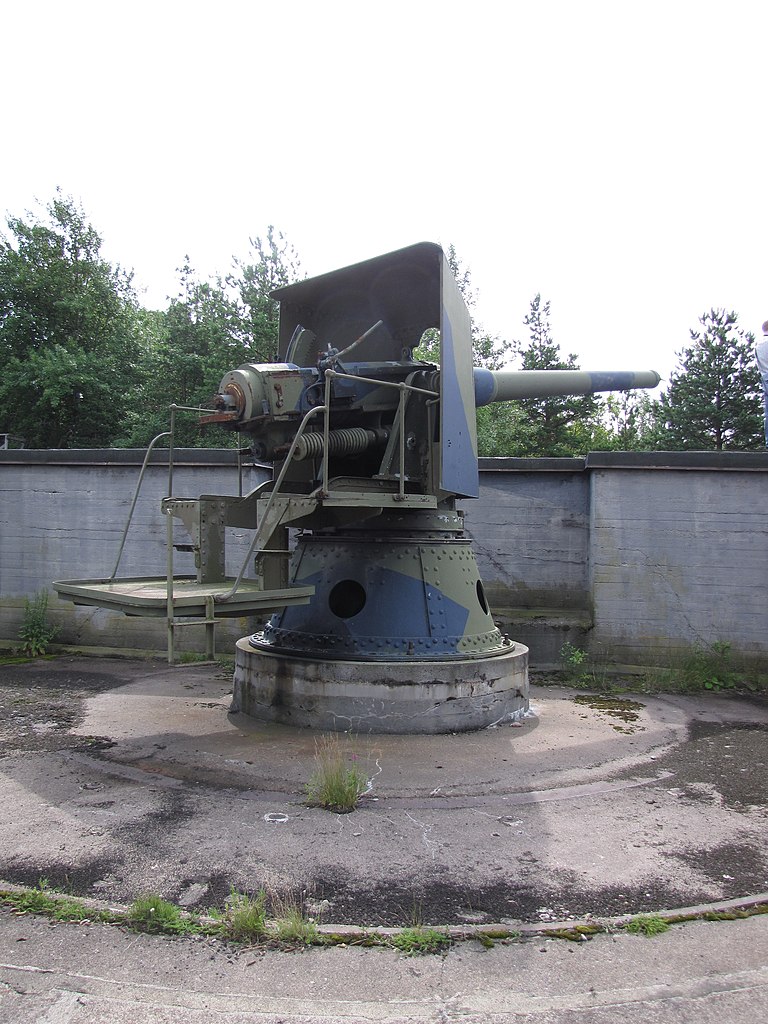
A former Finnish Canet 152 mm used in fortifications during WW2, former naval gun.
The Canet 15 cm/52 guns: The Canet (Russified as “Kane”) cannon was a naval, rapid-fire, medium-caliber cartridge gun designed by the French Navy and also used by the Russian and other navies. Developed by Forge & Chantier de la Mediterranée, under the guidance of chief engineer Gustave Canet. It first entered service in 1889. The first Russian ship armed with it was the armored cruiser Rurik. It was adopted by the Russian fleet on August 31, 1891.
Specs:
Barrel length: 6858mm/45 caliber
Type: Piston valve Recoil hydraulic system, Unitary loading
Barrel weight with sliding block: 5815-6290Kgs
Projectile weight: 41.4-49.76 kgs
Initial muzzle velocity: 229-793m/s
Rate of fire: 7-10 rpm
Gun mount weight: 14,690 kgs, trunk radius 4823 mm, rollback length 375-457 mm,
Elevation/Traverse: °20, 1.1°s/sec. and traverse 2.3°sec.
Maximum firing range: 11,523-15,910m (20°-25°)
Shield armour thickness: 25 mm
Crew: 10
Secondary: 12x 75mm/50 Canet

A Canet 75 mm aboard Gromoboi.
The 75 mm Canet designed by Gustave Canet was built under a French licence in Russia and entered service in 1892 until 1920. A total of 799 were produced, 248 at the Motovilikhinsky plants in Perm and 551 at the Obukhov steel plant.
Specs:
Weight: kg 879-910 kg in combat position
Barrel length: mm 3750/75 caliber
Elevation/Traverse -10° to 20° and 360°
rate of fire: 12-15 rpm
Range: shrapnel 8,967 m/40°, HE 9,150m/35° or 6,405 m/13°
light Guns and MGs
8x 47 mm Hotchkiss Guns

Single mount 47 mm (3-pdr) Hotchkiss gun. First produced in 1885. Quickspecs: Weight, 240 kg in firing position, Barrel length 43.5 mm/47 caliber ROF 15 rpm, sighting range 4.6 km.
63.5-mm Baranovsky cannons
First issued to the Army in 1878. Weight 272 kgs with the wheeled undercarriage, Barrel length 19.8 mm (1260 mm overall with undercarriage)/ 63.5mm caliber, Elevation -10° to 15° ROF 5 shots per minute, Sighting range, approx 4.6 km
37 mm Hotchkiss
A model that can be dismounted to be relocated on a pintle fitted on a steam cutter. Similar to the French model Hotchkiss cannon.
Maxim-Nortdenfelt 0.8 mm machine guns
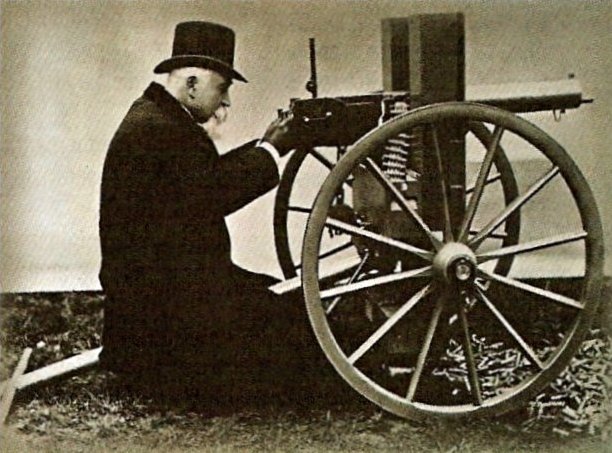
The great standard present on virtually all Russian ships since 1885 and produced under licence. Weight, kg 27.2 Length, mm 1067 Barrel length, mm 721 Cartridge 7.62 × 54 mm R (“Maxim” mod. 1910)
7.92×57mm (MG 08) .303 British (“Vickers”) 7.5×55mm Schmidt-Rubin (MG 11) 8×50mm R Mannlicher Caliber, mm 7.62; 7.92; 7.7 (.303); 7.5; 8 mm Principles of operation barrel recoil with short stroke, crank-and-rod locking rate of fire, shots/min 600 starting speed bullets, m/s 740 Type of ammunition machine-gun belt for 250 rounds
Six 381 mm torpedo tubes
It was likely the 15″ (381mm) Type “L” Whitehead which equipped all Russian ships in 1898, carrying an explosive charge of 141 lbs. (64 kg) TNT for a Range/Speed of 980 yards (900 m)/25 knots
or 660 yards (600 m)/29 knots settings.

Various liveries of the ship during her career (pinterest)

Conway’s profile as completed in 1902
⚙ specifications |
|
| Displacement | 6,500 long tons (6,604 t) |
| Dimensions | 129.6 x 15.8 x 6.3 m (425 ft 2 in x 51 ft 10 in x 20 ft 8 in) |
| Propulsion | 2 shafts VTE, 30 Niclausse boilers 20,000 ihp (15,000 kW) |
| Speed | 23 knots (43 km/h; 26 mph) |
| Range | 6,100 miles |
| Armament | 12× 152mm, 12× 75mm, 8× 47mm, 2× 37 mm, 6× 381 mm TTs |
| Protection | See notes |
| Crew | 570 |
Read More

Model of the ship in St Petersburg Museum
Books
Links
ru.wikipedia.org/wiki/Аскольд_(бронепалубный_крейсер)
on commons.wikimedia.org/
https://ru.wikipedia.org/wiki/%D0%9C%D0%BE%D1%80%D1%81%D0%BA%D0%BE%D0%B9_%D1%81%D0%B1%D0%BE%D1%80%D0%BD%D0%B8%D0%BA
https://ru.wikisource.org/wiki/%D0%92%D0%AD/%D0%92%D0%A2/%D0%94%D0%B6%D0%B5%D0%B2%D0%B5%D1%86%D0%BA%D0%B8%D0%B9,_%D0%A1%D1%82%D0%B5%D0%BF%D0%B0%D0%BD_%D0%9A%D0%B0%D1%80%D0%BB%D0%BE%D0%B2%D0%B8%D1%87
http://www.navweaps.com/Weapons/WTRussian_Main.php
https://ru.wikisource.org/wiki/%D0%91%D0%A1%D0%AD1/%D0%91%D1%80%D0%BE%D0%BD%D0%B5%D0%BD%D0%BE%D1%81%D0%BD%D0%B0%D1%8F_%D0%BA%D0%B0%D0%BD%D0%BE%D0%BD%D0%B5%D1%80%D1%81%D0%BA%D0%B0%D1%8F_%D0%BB%D0%BE%D0%B4%D0%BA%D0%B0
https://ru.wikipedia.org/wiki/%D0%9C%D0%B8%D0%BD%D0%BD%D1%8B%D0%B9_%D0%BA%D1%80%D0%B5%D0%B9%D1%81%D0%B5%D1%80
Model Kits
Askold’s Career 1902-1919
Early Baltic fleet service and trip (1902-1903)
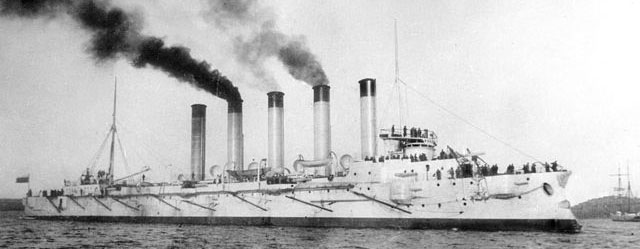
As soon as she was completed in Germany, Askold started her sea trials and shakedown cruise after being commissioned as part of the Baltic Fleet. Due to the growing tension between Russia and Japan, a detachment under the command of Rear Admiral Baron E. A. Shtakelberg was sent to the Russian Far East in 1903, including the battleships “Retvizan” and “Victory”, the cruisers “Bogatyr”, “Diana” and “Pallada”. The cruisers “Askold”, “Novik” and “Boyarin” and seven destroyers meanwhile were gathered in Libau to join the squadron en route for the far east via the Skagerrak. On October 31, the detachment set off from Libau and crossed the Skagerrak, then entered the north sea. At that time, “Askold” and “Novik” went far ahead of the detachment while testing their powerplants. They were reorganized on the fly as a screening detachment.
Concluding their trip to the Mediterranean, Askold and Varyag stopped to Muscat, Oman, after crossing the Suez canal. There, officers met with the local sultan. The Russian ships left a deep impression on the latter, confirming the preferrence of the Turkish admiralty for German engineering in the future. Upon arrival in the Pacific, Askold for some time was part of the emerging Vladivostok detachment, composed only of protected cruisers.
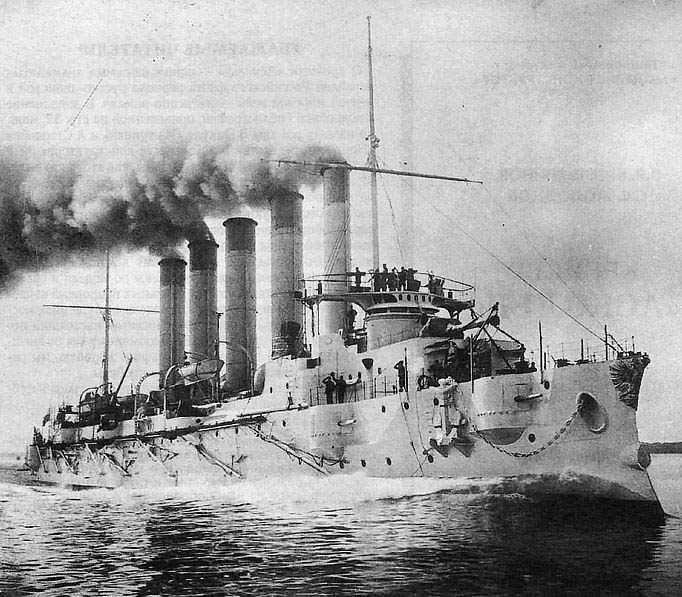
In Vladivostok
During training artillery firing, Askold’s gunners showed that they were among the best in the squadron, firing eight times more accurately than Varyag’s. On August 19, in Peter the Great Bay, the cruiser fired on the move at 18 knots with a wind of 3-4 points on target. Although visibility was poor, the target was often hidden in the fog, Askold’s gunners showed good results: Out of 36 152-mm shells fired, seven hit the target, 12 out of 36 shells for the secondary and 5 out of the 40 for light guns. Varyag during a similar shooting on December 16, 1903, last exercises before combat, while at lower speed (12.5 knots), out of 36 main shells, only put 33 on target. For the 75-mm, 47-mm and 37-mm, only landed three.
Untimately later in 1903, the cruiser was transferred to the Port Arthur base.
In Port Arthur
On the eve of the war, Askold, Pallada, “Diana, Novik, Boyarin, Bayan, the auxiliary cruiser “Angara”, four gunboats and all destroyers were based in Port Arthur.
In connection with talks from Japan, governor Admiral E. I. Alekseev on January 18, 1904, gave the order to immediately start the campaign. The next day at high tide, a detachment entered the outer roadstead of Port Arthur. On January 21, at 16:00 Askold as the lead ship saw the Shantung lighthouse after which, by order of the governor, the fleet turned back and at 5 am on January 22, anchored in Dalyanvan Bay. In the afternoon, they moved back to Port Arthur.
On the night of January 27, the Russian squadron was anchored in Port Arthur roadstead when attacked by Japanese destroyers. Some ships returned fire, but the squadron commander Vice Admiral O. V. Stark, did not believed the seriousness of the situation at first and ordered flagship Petropavlovsk to direct her searchlight beam into the sky, a prearranged signal for a ceasefire !.
It’s only at 0:55 that he realized his mistake and ordered Askold and Novik to start their chase of Japanese destroyers, hwhich by then already disappeared. Askold was later joined by the battleship Tsesarevich hit by a torpedo, and having an increasing roll, headed for the inner harbor for repairs. The squadron repelled a second attack by destroyers.
Admiral Togo, who commanded the attack, reported to his superiors that Poltava, Askold and two other large ships has been put out of action, which was not the case. The Japanese, despite the short distance, could not correctly identify the silhouettes of the Russian ships.
Askold became soon one of the most active ships of the Port Arthur squadron. She participated many operations between gunnery duels with IJN cruisers covered her destroyers, repelled attacks from IJN destroyers, inspected suspicious merchant ships.
Various notable actions
Night of January 28-29: Askold, Bayan, Diana, Boyarin, Zabiyaka, Gaydamak”, Beaver, Gilyak”, Brave under command of M. P. Molasa occupied positions to guard the exit to the outer roadstead of Port Arthur.
February: On February 9, the 1st Pacific Squadron clashed with the 3rd combat detachment of Vice Admiral S. Dev (1st squadron, United Fleet) and IJN Armored cruisers targeted Askold, notabl the flagship Chitose and Takasago. On the 14th, Petropavlovsk while being repaired, was blown aground by a typhoon an nearly collided with Askold and Novik which quickly moved positons. On the 28th O. V. Stark was removed from command, Vice Admiral S. O. Makarov appointed, making Askold his flagship.
March: On the 9th, the Russian squadron (S. O. Makarov) sortied and duelled for for two hours with the main IJN fleet, 6 battleships, 6 armored and 6 armored cruisers. But this artillery duel did not bring significant results. The 17th, captain of the 1st rank N.K. Reitsenshtein was approved as junior flagship squadron commandr, raising his flag aboard Askold. On July 12 he would be promoted as Rear Admiral.
April: Night of 12-13th, a battle near Port Arthur started between the destroyer Terrible and 2nd TBs detachment. The Russian destroyer was sunk and Bayan intervened, but she was fired upon by the IJN 3rd combat detachment ‘s cruiser covering the transport Corio-maru laying a minefield. Petropavlovsk followed as Poltava, Askold, Diana and Novik and opened fire on Japanese cruisers in tuen, and at 09:15 in the morning, the 1st combat detachment arrived (Nissin and Kasuga) and Pobeda and Peresvet approached, starting chasing the withdrawing Japanese ships. At 09:43, the flagship Petropavlovsk hit a mine and sank. Vice Admiral S. O. Makarov went down with her.
July: On the 26th Askold, Bayan, Pallada and Novik entered the Lunwantan Bay and duelled with Japanese ships arrived to support the 3rd Japanese army, notably Akitsushima, Suma and Itsukushima.
On the 28th Admiral Kamimura’s 3rd battle detachment (Azuma, Tokiwa) was sent to Ross Islands to intercept Askold, Novik, Tsesarevich and several destroyers managing to break through the blockade. Izumo and Iwate were sent meanshile to intercept them in the Korea Strait. They also needed to block reinforcements from Vladivostok, the cruisers Russia, Gromoboy and Rurik. The Kamimura detachment met and fought them eventually in the Korea Strait.
Battle of the Yellow Sea
The 28 July saw the start of battle of the Yellow Sea: Askold was leading teh line as flagship, cruiser detachment Rear Admiral N. K. Reizenstein. They accuracte and plentiful fire manage to forced the Japanese armored cruisers to retreat, first Asama, and then Yakumo. Askold proved the superiority of her marksmanship and volume of fire. However the general breakthrough to Vladivostok of Port Arthur ships did not past the Japanese squadron, and only Askold and Novik managed to take their distance at top speed, and were eventually separated from the rest of the Russian ships, heading north.
For some time, only Suma followed them and duelled along the way, and soon Chitose, Akitsushima and Kasagi joined in, until they were distanced, they lef the chase and return south to the developping battle. Due to heavy damage on Aksold, two underwater holes and the aftmost funnel cut off, led to a decreasing speed and seaworthiness, down to 15 knots; Also half of the 6-inch artillery was disabled along the way. The commander took decision to stop the northwards run and go to Neutral Shanghai instead.
On the night of August 11, Admiral M. Togo sent the 6th combat detachment (Akashi, Akitsushima and Izumi) to catch them out. They eventually spotted Askold but Akitsushima developed steering troubles and machinery issue and fell from the line. Noticing their approach Askold rang general quarters, while the machinery crew worked wonders to augment top speed. By 06:00 the Japanese ships were distanced, stopped the chase, and Askold safely reached Shanghai. This evening, she was blocked in port by superior Japanese forces, and due to neutrality rules, had to be disarmed. The cruiser was interned by the Chinese government until the end of the war.
As part of the Siberian military flotilla
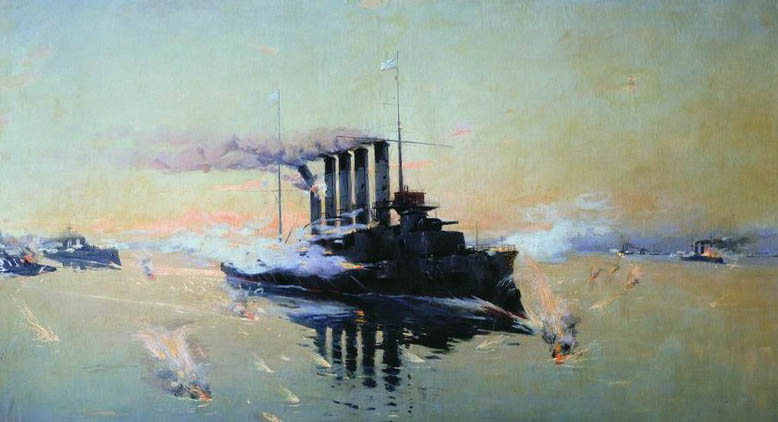
After the end of the war, “Askold” returned to Russia, but close to Vladivistok: She was enlisted in the Siberian military flotilla, as flagship. On October 16, 1907, a miners uprzizing at the fortress mine battalion in Diomede Bay erupted and the next day sailors of the Siberian flotilla’s destroyers rebelled. On October 17, the uprising was supported by the destroyer Skory, on which Yakov Poylov and Maria Maslikova, killed the commander of the destroyer, Senior Lieutenant A.P. Shter and seized command. Soon Askold (which also had rebels) aboard and still loyal ships tried to get out of the Golden Horn Bay, but they were engaged by rebel destroyer; Askold will received 67 hits. Her engine room was pierced, boiler blown up, steering was lost too and she was beached onto the shore of the bay.
From 1907, Askold, repaired, participated in currents studies in the Pacific under Major General M.E. Zhdanko, using the “bottle mail” with notes on the latitude and longitude of the place where the bottle was dropped, and a request to inform the address of the ETW where and when the message was discovered. Also, the Ussuri mine layer, the Okhotsk transport and the Neptune sailing schooner were involved in these experiments. On September 3, 1908, Askold took part in extended exercise with submersibles on a training attack.
World War I
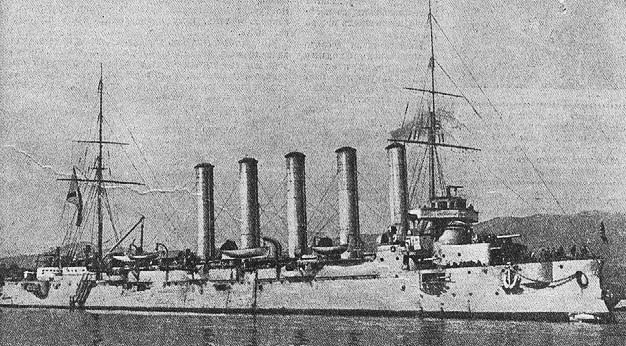
At 05:30 on July 20, 1914, a flag signal was raised over the Askold cruiser: “Germany has declared war” and thus the Siberian flotilla was urgently put on alert. Allied countries proposed to Russia to create a joint squadron in the Pacific and Indian Oceans to operate against the Von Spee’s Pacific squadron. Navy Minister Admiral Ivan Grigorovich was against this proposal, and the commander of the Siberian military flotilla, Rear Admiral M.F. S. A. Ivanov also opposed it at first but eventually agreed to detach from the flotilla the cruiser Zhemchug (commander Captain 2nd Rank Baron I. A. Cherkasov) to the Allied fleet.
On August 25, Zhemchug and Askold left Vladivostok for Hong Kong and joined the Allied forces placed under overall command of IJN Vice Admiral T.M. Jerama. On August 19, Russian cruisers searched for the Emden operating in the Indian Ocean. On August 22, Askold departed alone in search.
1916-1917: Mediterranean
After receiving the latest reports and new orders, she was sent to the Mediterranean Sea, redeployed against the Ottoman Empire and Austria-Hungary. She was to take part in the Dardanelles operation. Her on landing party fough ashore together with the French military, on the Asian coast of the peninsula in the Kum kale, as a diversion the main allied landing site on the Gallipoli Peninsula. This contributed to the successful completion of the operation at Cape Helles.
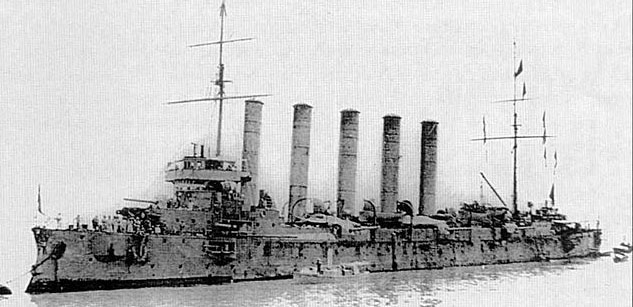
In March 1916, Askold arrived in France for an overhaul. On the night of August 20-21, 1916, however an explosion occurred in a magazine. The command blamed the sailors, who had previously been considered “unreliable”, although direct evidence of their involvement was never found. Afterinvestigation, the ship’s court sentenced four sailors accused of sabotage: Zakharov, Beshentsev, Shestakov and Biryukov, sentenced to death. About 150 sailors were sent in floating prisons and penal battalions. On November 6, 1916, while in Toulon, Captain 1st Rank K.F. Ketlinsky took command of Askold. Soon he approved all the guilty verdicts of court. After the revolution, this angered sailors against officers. Some accused them of having staged a provocation in order to identify and eliminate the “Bolshevik underground”.
The Arctic Fleet (1917-18)
In June 1917, after her refit, Askold under Ketlinsky departed from the Mediterranean and sailed for home, Murmansk to became part of the flotilla of the Arctic Ocean (White sea). In 1917, by the Decree of the Provisional Government, Askold’s Captain K. F. Ketlinsky was appointed commander of the entire northern coast of the Kola Peninsula, with the rank of Rear Admiral. A. I. Sheikovsky was appointed as captain to the Askold instead. On October 7, 1917, the Arctic Ocean Flotilla comprised the battleship Chesma, the cruisers Askold and Varyag, destroyers Kapitan Yurasovsky, Lieutenant Sergeev, Silent, Fearless, Vlastny, Grozovoi, submarine Saint George, minelayer Ussuri, 18 messenger ships, 43 minesweepers, 4 hydrographic vessels, 3 transports, 8 port ships and icebreakers Svyatogor and Mikula Selyaninovich. Northing much happened until the end of 1917 and in 1918.
As HMS Glory IV and fate
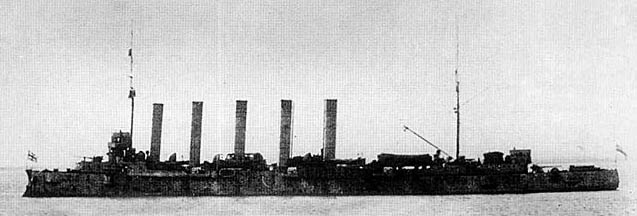
In 1918, the fleet moored in the Kola Bay came under the control of the allies. Both cruisers ended as floating barracks. In May 1919, Captain 2nd Rank B.A. Nolde, arrived on an English icebreaker, to be placed in command of the cruiser and ensure it stays with the “white Russians”. In July 1919, Askold was officially integrated into the British Navy under the name ‘Glory IV’.
In 1922, she was purchased by Soviet Russia. She was examined by a team, which estimated due to all thes eyears of neglect, her poor technical condition only left the option of selling her for scrap, transferred to the German-Russian joint-stock company Derumetal. She was towed to Hamburg for scrapping the same year.


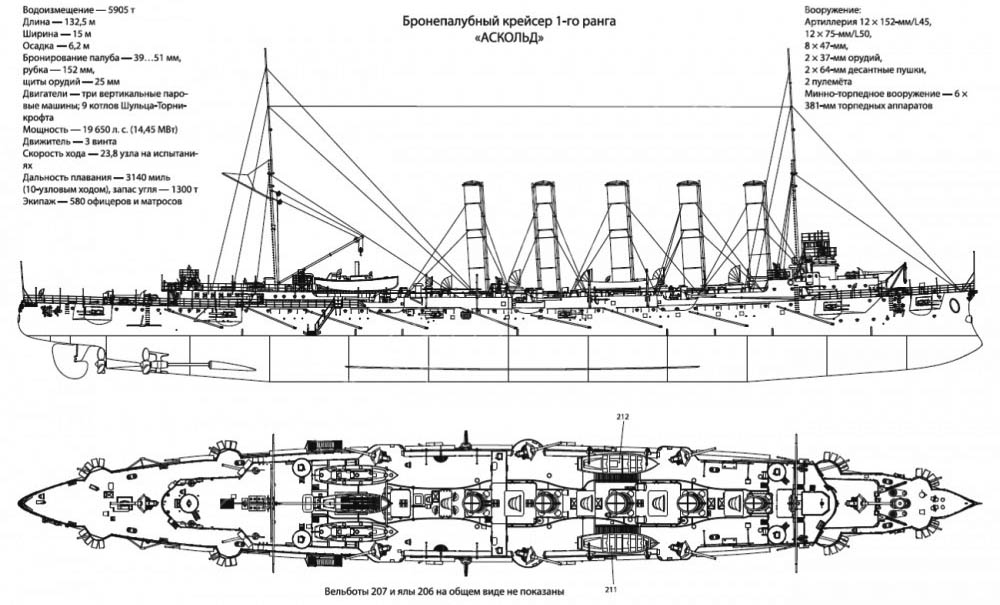
 Latest Facebook Entry -
Latest Facebook Entry -  X(Tweeter) Naval Encyclopedia's deck archive
X(Tweeter) Naval Encyclopedia's deck archive Instagram (@navalencyc)
Instagram (@navalencyc)





 French Navy
French Navy Royal Navy
Royal Navy Russian Navy
Russian Navy Armada Espanola
Armada Espanola Austrian Navy
Austrian Navy K.u.K. Kriegsmarine
K.u.K. Kriegsmarine Dansk Marine
Dansk Marine Nautiko Hellenon
Nautiko Hellenon Koninklije Marine 1870
Koninklije Marine 1870 Marinha do Brasil
Marinha do Brasil Osmanlı Donanması
Osmanlı Donanması Marina Do Peru
Marina Do Peru Marinha do Portugal
Marinha do Portugal Regia Marina 1870
Regia Marina 1870 Nihhon Kaigun 1870
Nihhon Kaigun 1870 Preußische Marine 1870
Preußische Marine 1870 Russkiy Flot 1870
Russkiy Flot 1870 Svenska marinen
Svenska marinen Søværnet
Søværnet Union Navy
Union Navy Confederate Navy
Confederate Navy Armada de Argentina
Armada de Argentina Imperial Chinese Navy
Imperial Chinese Navy Marinha do Portugal
Marinha do Portugal Mexico
Mexico Kaiserliche Marine
Kaiserliche Marine 1898 US Navy
1898 US Navy Sovietskiy Flot
Sovietskiy Flot Royal Canadian Navy
Royal Canadian Navy Royal Australian Navy
Royal Australian Navy RNZN Fleet
RNZN Fleet Chinese Navy 1937
Chinese Navy 1937 Kriegsmarine
Kriegsmarine Chilean Navy
Chilean Navy Danish Navy
Danish Navy Finnish Navy
Finnish Navy Hellenic Navy
Hellenic Navy Polish Navy
Polish Navy Romanian Navy
Romanian Navy Turkish Navy
Turkish Navy Royal Yugoslav Navy
Royal Yugoslav Navy Royal Thai Navy
Royal Thai Navy Minor Navies
Minor Navies Albania
Albania Austria
Austria Belgium
Belgium Columbia
Columbia Costa Rica
Costa Rica Cuba
Cuba Czechoslovakia
Czechoslovakia Dominican Republic
Dominican Republic Haiti
Haiti Hungary
Hungary Honduras
Honduras Estonia
Estonia Iceland
Iceland Eire
Eire Equador
Equador Iran
Iran Iraq
Iraq Latvia
Latvia Liberia
Liberia Lithuania
Lithuania Mandchukuo
Mandchukuo Morocco
Morocco Nicaragua
Nicaragua Persia
Persia San Salvador
San Salvador Sarawak
Sarawak Uruguay
Uruguay Venezuela
Venezuela Zanzibar
Zanzibar Warsaw Pact Navies
Warsaw Pact Navies Bulgaria
Bulgaria Hungary
Hungary

 Bundesmarine
Bundesmarine Dutch Navy
Dutch Navy Hellenic Navy
Hellenic Navy Marina Militare
Marina Militare Yugoslav Navy
Yugoslav Navy Chinese Navy
Chinese Navy Indian Navy
Indian Navy Indonesian Navy
Indonesian Navy JMSDF
JMSDF North Korean Navy
North Korean Navy Pakistani Navy
Pakistani Navy Philippines Navy
Philippines Navy ROKN
ROKN Rep. of Singapore Navy
Rep. of Singapore Navy Taiwanese Navy
Taiwanese Navy IDF Navy
IDF Navy Saudi Navy
Saudi Navy Royal New Zealand Navy
Royal New Zealand Navy Egyptian Navy
Egyptian Navy South African Navy
South African Navy






























 Ukrainian Navy
Ukrainian Navy dbodesign
dbodesign